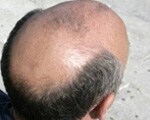Men with prostate cancer may be twice more likely to have started showing signs of male pattern baldness at the age of 20 years than those without prostate cancer.

Until now there has been conflicting evidence about the link between balding and prostate cancer; this is the first study to suggest a link between going bald at the young age of 20 and the development of prostate cancer in later life.
Male pattern baldness (androgenic alopecia) is very common, affecting about half of all men at some point in their lives. Its onset has previously been linked to the conversion of testosterone to androgenic hormones, and androgens have also been previously implicated in the onset and growth of prostate cancer. The drug finasteride - used to treat baldness - blocks the conversion of testosterone to an androgen thought to cause hair loss, and the drug has also been demonstrated to lower the incidence of prostate cancer.
To explore the possible connection between balding patterns and prostate cancer, researchers spent more than two years analysing disease progression and hair loss patterns in 388 men with prostate cancer in Paris. The men were diagnosed between the ages of 46 and 84 years. Starting in 2004, the study participants answered a questionnaire about their personal history of prostate cancer (if any) and to indicate on four pictures any balding patterns that they had at ages 20, 30 and 40. The pictures showed four stages of hair loss: no balding (stage I), frontal hair loss (receding hairline around the temples), vertex hair loss (a round bald patch at the top of the head), or a combination of both types of hair loss (stage IV). The men's doctors were also asked to provide a medical history of their patients, including any diagnosis of prostate cancer, age at diagnosis, stage of the disease and treatment. Another 281 healthy men were enlisted in the study for comparison. The study ran for 28 months.
It was found that 37 of the prostate cancer patients (and 14 of the healthy men) had experienced some form of hair loss at the age of 20 years, ranging from a receding hairline to a bald patch at the top of the head, or a combination of both. Any form of hair loss at age 20 years was linked to a doubling of prostate cancer risk, the study authors reported. Men who start losing their hair in their 30s or 40s did not appear to face a similar boost in prostate cancer risk. And those whose hair loss started in their 20s did not face a higher risk of developing the cancer at an early age or of developing more aggressive tumours. The study found no association between early hair loss and an earlier diagnosis of prostate cancer, and nor was there any link between the pattern of hair loss and the development of cancer. Whether or not men who experience youthful hair loss may benefit from prostate cancer screening is yet to be determined.
The researchers cautioned, however, that it is premature to conclude that baldness and prostate cancer are, in fact, linked. Noting that androgens associated with hair loss are also associated with prostate cancer, the researchers called for more studies to see whether interventions might be appropriate for men with very early balding. Physicians need to know who could be targeted for screening and also considered for chemo-prevention using anti-androgenic drugs.
DoctorNDTV is the one stop site for all your health needs providing the most credible health information, health news and tips with expert advice on healthy living, diet plans, informative videos etc. You can get the most relevant and accurate info you need about health problems like diabetes, cancer, pregnancy, HIV and AIDS, weight loss and many other lifestyle diseases. We have a panel of over 350 experts who help us develop content by giving their valuable inputs and bringing to us the latest in the world of healthcare.












